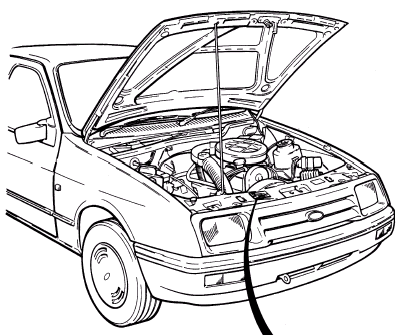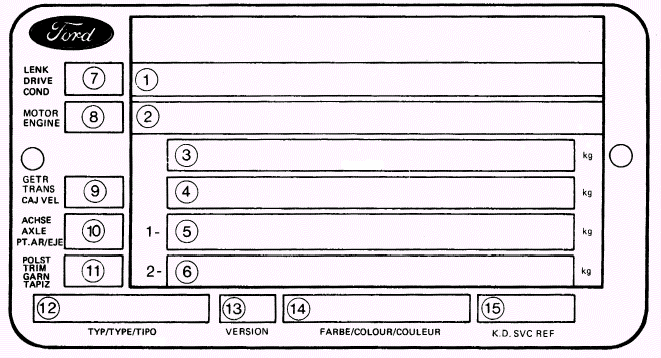Vehicle Identification Number (VIN) Plate

 |
1 Type approval number
2 Vehicle identification number (VIN)
3 Gross vehicle weight
4 Gross train weight
5 Permitted front axle loading
6 Permitted rear axle loading
7 LHD or RHD
8 Engine code
9 Transmission code
10 Final drive code
11 Interior trim code
12 Vehicle type number
13 Blank
14 Paint code
15 Blank
|
 Modifications are a continuing and unpublicised process in vehicle manufacture,
quite apart from major model changes. Spare parts lists are compiled upon a numerical
basis, the individual vehicle identification numbers being essential to correct
identification of the component concerned.
When ordering spare parts, always give as much information as possible. Quote the car
model, year of manufacture, body and engine numbers, as appropriate.
The Vehicle Identification Number (VIN) plate is mounted on the right-hand side of the
body front panel, and may be seen once the bonnet is open (see illustration). Besides the
VIN it also carries information on vehicle equipment and permissible loads.
The engine number is situated on the cylinder block. On SOHC engines, the number
is located on the right-hand side of the cylinder block in front of the engine mounting
bracket. On 1.8 litre (R2A) CVH engines, the number is located on the front upper
right-hand side of the cylinder block. On 1.6 and 1.8 litre (R6A) CVH engines, the engine
number is stamped on the front lower face of the cylinder block, on the alternator side of
the timing cover. On DOHC engines, the engine number is stamped on the front face of
the cylinder block, below the upper timing chain cover.
Other identification numbers or codes are stamped on major items such as the gearbox,
final drive housing, distributor etc. These numbers are unlikely to be needed by the
home mechanic.
Modifications are a continuing and unpublicised process in vehicle manufacture,
quite apart from major model changes. Spare parts lists are compiled upon a numerical
basis, the individual vehicle identification numbers being essential to correct
identification of the component concerned.
When ordering spare parts, always give as much information as possible. Quote the car
model, year of manufacture, body and engine numbers, as appropriate.
The Vehicle Identification Number (VIN) plate is mounted on the right-hand side of the
body front panel, and may be seen once the bonnet is open (see illustration). Besides the
VIN it also carries information on vehicle equipment and permissible loads.
The engine number is situated on the cylinder block. On SOHC engines, the number
is located on the right-hand side of the cylinder block in front of the engine mounting
bracket. On 1.8 litre (R2A) CVH engines, the number is located on the front upper
right-hand side of the cylinder block. On 1.6 and 1.8 litre (R6A) CVH engines, the engine
number is stamped on the front lower face of the cylinder block, on the alternator side of
the timing cover. On DOHC engines, the engine number is stamped on the front face of
the cylinder block, below the upper timing chain cover.
Other identification numbers or codes are stamped on major items such as the gearbox,
final drive housing, distributor etc. These numbers are unlikely to be needed by the
home mechanic.


 Modifications are a continuing and unpublicised process in vehicle manufacture,
quite apart from major model changes. Spare parts lists are compiled upon a numerical
basis, the individual vehicle identification numbers being essential to correct
identification of the component concerned.
When ordering spare parts, always give as much information as possible. Quote the car
model, year of manufacture, body and engine numbers, as appropriate.
The Vehicle Identification Number (VIN) plate is mounted on the right-hand side of the
body front panel, and may be seen once the bonnet is open (see illustration). Besides the
VIN it also carries information on vehicle equipment and permissible loads.
The engine number is situated on the cylinder block. On
Modifications are a continuing and unpublicised process in vehicle manufacture,
quite apart from major model changes. Spare parts lists are compiled upon a numerical
basis, the individual vehicle identification numbers being essential to correct
identification of the component concerned.
When ordering spare parts, always give as much information as possible. Quote the car
model, year of manufacture, body and engine numbers, as appropriate.
The Vehicle Identification Number (VIN) plate is mounted on the right-hand side of the
body front panel, and may be seen once the bonnet is open (see illustration). Besides the
VIN it also carries information on vehicle equipment and permissible loads.
The engine number is situated on the cylinder block. On